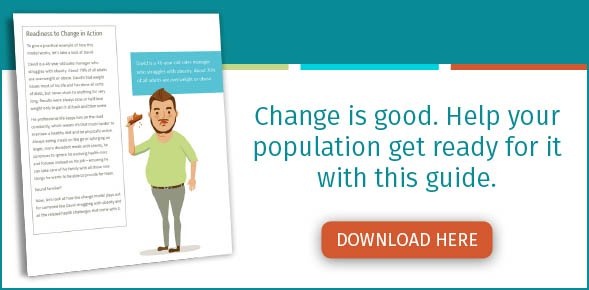Health risk assessments (HRAs) allow you to get a big-picture view of your population. You always have opportunity to provide resources on an individual basis and offer assistance before someone hits “high-risk” status. But one of the benefits when population buy-in is high is that you can also see prevalent unhealthy habits and potentially intercept chronic diseases on a larger scale.

Consider an organization with a varied workforce. As you look at your data, you may notice low flu vaccination rates or high sugar intakes in wide swaths of your population. Perhaps workers in a particular age group are inactive and at higher risk of cardiovascular disease, for example. Either way – whether systemic or demographic – observations such as these will allow you to determine which types of interventions are appropriate for your population.
When we looked at aggregated customer data from Wellsource Workforce HRAs completed in 2017, we observed that:
- About half (55%) do not meet the recommended physical activity level of at least 30 minutes per day and strength-building exercises two times a week
- Nearly 9 in 10 (87%) of employees experienced some level of stress and 3 in 5 said they were under continual or frequent stress
It’s likely that similar statistics exist within your organization. So how can you provide assistance and see a positive population health trend in self-reported fitness, stress management, and sleep?
A Sedentary Lifestyle
Help combat the risks associated with a sedentary lifestyle – such as obesity, type 2 diabetes, and cardiovascular disease – by encouraging your population to get moving:
- Holding walking and stand-up meetings
- Taking a minute to stretch every hour or two during the day
- Using apps to remind employees to stand up from their desks or go on break
- Providing standing desks to those who want them
- Asking managers to encourage their teams to step away from their desk and take a quick walk
We should note that doing things like starting FitBit competitions sound great in theory, but can backfire when put into place in a work setting.
High Stress Levels
Psychological distress can lead to chronic conditions. And with nearly half of American adults self-identifying as “work martyrs,” it’s very likely that making changes in the workplace – or at least to the workday – could make a big impact.
To help lower stress levels, promote the benefits your population is entitled to, such as Paid Time Off (PTO) and sick time. Also, when possible, let them know that it’s okay to shut things down for the day – just because they receive an email or Slack message at 10 p.m. doesn’t mean they have to answer it. It will still be there in the morning.
It’s unlikely that you’ll be able to force anyone to take a vacation or not look at their phone, but you can help them make their time in the office more comfortable, literally. Interestingly, physical discomfort often leads to high levels of workplace stress. Provide your population with resources on ergonomic posture and do your best to provide new chairs, monitor stands, or footrests to those who would benefit from them.
You can also give tips on how to meditate, manage their calendars, or handle conflict in the workplace.
There are likely other trends within your population that you could help address. It should be noted that interventions must align with both need and change readiness. To learn more about helping your population make changes to their lifestyle, download our whitepaper, Change Readiness: The Critical Component to Wellness Engagement.








